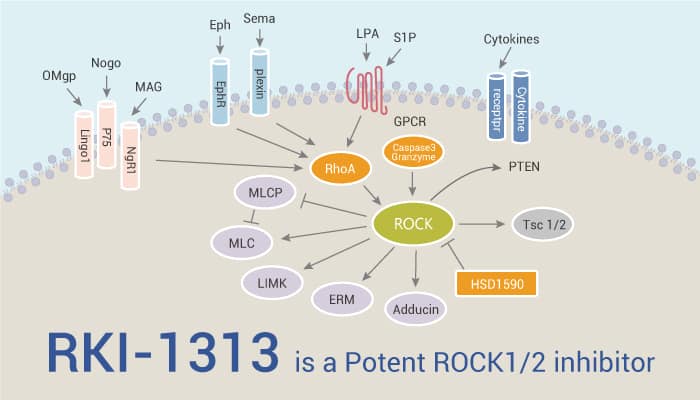ROCK is a kinase belonging to the AGC (PKA/PKG/PKC) family of serine threonine-specific protein kinases. Specifically, ROCK is one of the best characterization effectors of RhoA, a small GTPase. It mainly regulates the shape and movement of cells by acting on the cytoskeleton. Besides, ROCK is the main downstream effector of RhoA. Moreover, ROCK promotes actin-myosin mediated contractility by phosphorylating a variety of downstream target proteins. ROCK can stimulate actin contractility by directly acting on MLC2 or indirectly increasing MLC2 phosphorylation by inactivating MLC phosphatase. Furthermore, ROCK controls cell shape, adhesion, and migration by regulating the contractility of actin-myosin. This is achieved by the phosphorylation of several major substrates by ROCK.
Meanwhile, The ROCK family consists of two members, ROCK1 and ROCK2. The two proteins have 92% overall sequence similarity in their kinase domain. Their absence leads to cell cycle arrest and cell aging. Nonetheless, ROCK plays an indispensable role in cell cycle progression and tumorigenesis. Particularly, ROCK1 and ROCK2 are essential for cancer cell migration and invasion. A large amount of evidence shows that the Rho GTPases/ROCK pathway plays a role in migration, invasion, and metastasis. This prompts the development of inhibitors that interfere with this pathway, which is a new antitumor drug. Today, we will introduce a ROCK inhibitor, RKI-1313.
RKI-1313 is a Potent ROCK1/2 inhibitor.

Cancer Res. 2012 Oct 1;72(19):5025-34.
First of all, RKI-1313 is a ROCK inhibitor with IC50s of 34, and 8 µM for ROCK 1 and ROCK 2, respectively. Interestingly, RKI-1313 shows little effect on the phosphorylation levels of ROCK substrates, migration, invasion, or anchorage-independent growth.
In the second place, RKI-1313 did not decrease P-MLC-2 at 10 μM consistent with its weak inhibitory activity against ROCK1 and ROCK2 in vitro. Importantly, RKI-1313 had little effect on inhibiting MDA-MB-231 tumor cell invasion.
All in all, RKI-1313 is a potent ROCK inhibitor.
References:
Patel RA, et al. Cancer Res. 2012 Oct 1;72(19):5025-34.